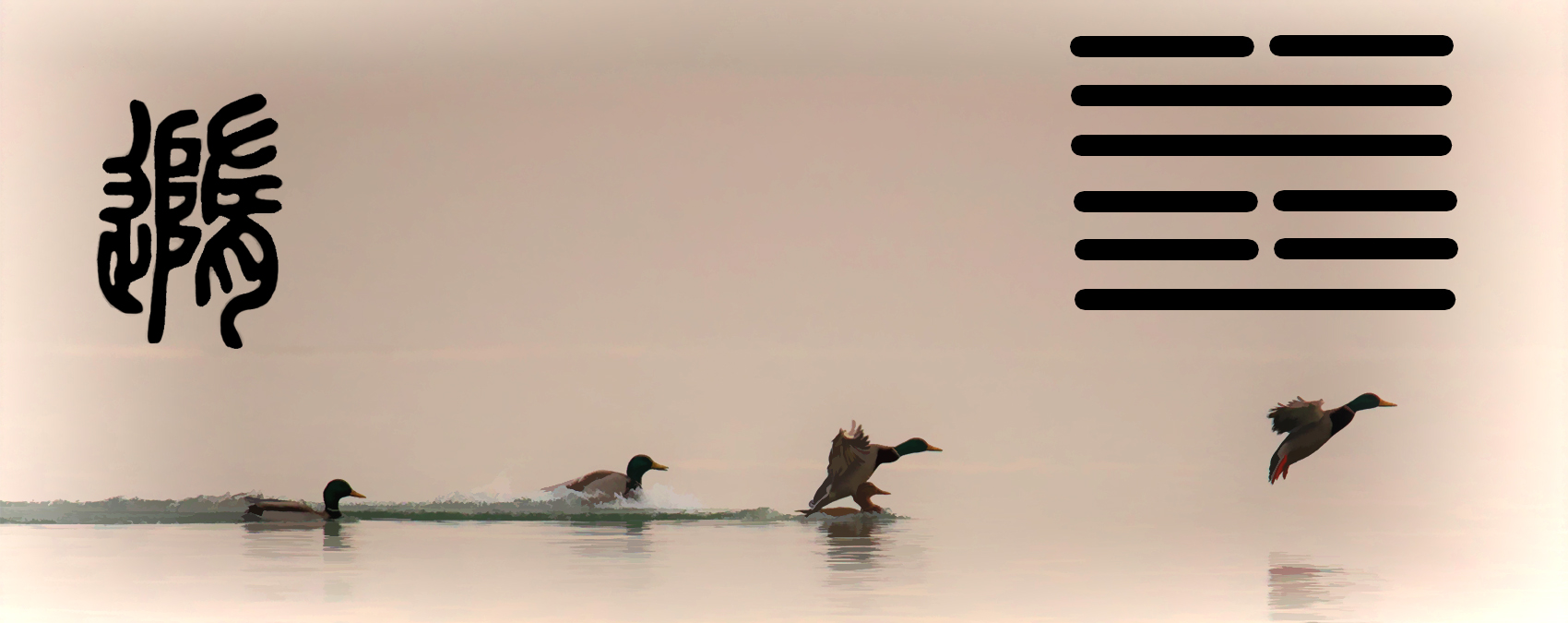Lake above – Thunder below
The Chinese name of this hexagram is Sui which originally meant “hunting” and later came to mean “amiably following” or “following without resistance”. In both trigrams the solid yang lines which are active, show deference by staying below (following) the broken yin lines (which are receptive) in a profound symbolism. One can follow good or bad things. It shows how, rather than chasing happiness, adjusting your course at the right time in accordance with present circumstances, happiness may find you. Other names for Sui: Adjusting, Hunting, According With.
Breaking down the symbolism of the 3-line trigrams helps with understanding the ancient teachings:

Trigram Thunder (lower 3 lines of the image below right) is referencing the inner realm of the person or situation. When trigram Thunder is within, its shock and impetus is moved through the outer trigram to allow the characteristics of Lake to become reality. Thunder can be seen as an initiator and a fertilizing force, but it is also usable physical and mental energy for insight, creativity and good luck.
Trigram Lake is on top of trigram Thunder. Lake has the attribute of “opening up joyful exchange” with others as well being “the place where people meet to have that exchange”. As the visible or externalized part of the Hexagram, Lake’s position here represents the reality of one’s environment, the terrain in which this situation unfolds. Of necessity, society has limits and rules to facilitate interchange and Lake is a defined space within the environment, so the largeness of Thunder must submit its power to these restrictions if it is to remain constructive.
The ancient ideograph is on the upper left portion of the image below. Originally the meaning was “hunting” with the left image as a road, the middle is a mound and on the right, a hand cutting meat – overall a picture of hunting in rough terrain. It was also seen as a “procession honoring the king”: the left portion shows the idea of walking, the middle displays 3 pennants mounted on a pole and on the right a guard following, holding a defensive weapon. Either way, following is illustrated.

In summary: Sui shows movement under the surface of the lake, useable energy propelling a person or situations into following; intuiting, tracking clues and learning about the world. One must apply effort to see how things “really are” and find the best way to exist within that reality. At the same time, one is encouraged to rest deeply in accordance with the night and seasons. Sui, in its highest expression, illustrates learning to follow the natural laws and rhythms within life by inserting oneself into the flow. It also brings up questions about what you follow or who you allow to lead.
Following are a few ideas for interpretations of each line:
Line 1 – Things have changed, calling one to move past what “used to be” and open to “what is unfolding now”. For some, change is not easy to accept, while others may not even notice it is time for change. Guidance shows the path to success is in moving out into the world and widening horizons by interacting with others.
Line 2 – Issues of immaturity are a focus of this position illustrating, for example, one who may be tempted to choose the first, easiest, flashiest or largest of anything being offered to him/her. Voices of the ancient wise ones suggest checking carefully to make sure you are following what is actually best suited to the demands of the current situation.
Line 3 – This line position holds a call to definitively seek a growth in perception which means following the path of the adult and taking responsibility for creating the change. Following this path does not, however, mean you need to be rigid and leave wonder, curiosity and astonishment behind.
Line 4 – Becoming too attached to the goal itself or caught up in trying to live up to the projections of others are possible pitfalls of this line position. One who “follows” natural laws and lives well lives in the present moment knows that personal skills and sincerity of purpose are just as, or even more important, than the goal.
Line 5 – A position of leadership means if you insist on the best, it is probably attainable. Much depends on the excellence of your own attitude in times of crisis. If moving through personal ordeals creates compassion rather than conceit, others may follow the skill and sincerity of your example and you may continue to find good leadership for yourself.
Line 6 – One at this position has come to a place of good integration; others may seek to follow you and be appreciative of your assistance. There may be a time of retreat ahead before a return to a new task.
